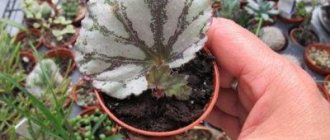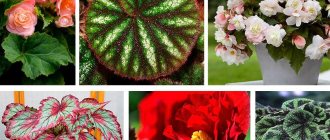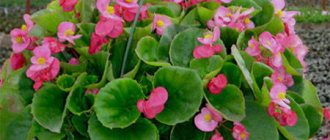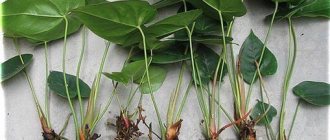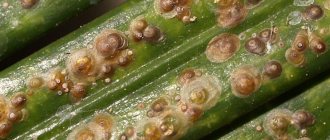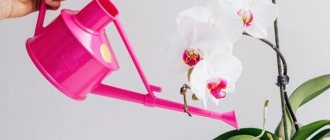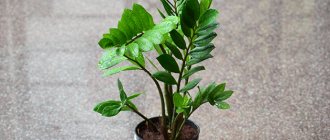- September 1, 2019
- Houseplants
- Efimova Anastasia
Begonia is one of the most beautiful and unpretentious indoor plants. It has enviable vitality and is very easy to propagate. In total, there are about 1000 different species of begonias - from three-meter giants to tiny ones that barely reach a height of 10 cm. Several popular species are grown everywhere in our country - graceful, sagging, royal, multi-flowered, elatior begonia. Propagation by leaf of any of them is not difficult. Although experienced gardeners claim that the method of propagating this magnificent flower should be chosen based on its characteristics - appearance, variety, characteristics of the leaves and root system.
Classification
Begonia is a tropical beauty native to Africa, Asia and South America. It got its name from the governor Fr. Haiti - M. Begona. All begonias are conventionally divided into two groups:
- Decorative blooming - with bright lush flowers and long flowering.
- Decorative-deciduous - with bright, attractive foliage and small, inconspicuous flowers.
Based on the type of root system, begonias are divided into tuberous, rhizomatous and plants with a superficial root system.
Among all the mentioned groups there are shrubs, subshrubs, creeping and erect herbaceous plants.
Popular types of indoor begonias
- A group of ever-blooming begonias. Shrubs are no taller than half a meter. The leaves are wide, smooth, and veined. The stems are dense and fleshy. The flowers are small, collected in large inflorescences. Popular varieties are graceful begonia, Schmidt begonia, Colombian (lanciana). These varieties are best propagated as a whole leaf, with a petiole.
- Tuberous. A large group of plants with different leaves - pubescent and smooth, and thick fleshy stems. Famous representatives are pendulous begonia, Sutherland begonia, multifloral. Tuberous plants are usually propagated by dividing the tuber. But other methods of obtaining new plants are quite acceptable.
- Royal or rex begonia. A low, up to half a meter, herbaceous plant with a developed root system. The leaves are asymmetrical, jagged, with a sharp apex. On the front side they are velvety, complex in color. The reverse side is green with burgundy veins. The leaves are attached to the trunk on long petioles, making the bush look lush. The flowers are inconspicuous, small, pink. Propagation by leaves of royal begonia is possible; moreover, this is one of the best methods for this type of plant. Popular varieties are snail, griffin, dollar doun (with a black border along the edge of the leaf).
- Ampelous begonias. A group of plants with beautiful inflorescences and creeping shoots. Most often they are propagated by layering and cuttings.
- Begonia elatior, or winter. A very beautiful long-flowering bush with bright green smooth heart-shaped leaves. Begonia is propagated by leaves, since it does not have stems or shoots. Representatives: Annabel, Piccora.
Optimal time
The optimal time for replanting is considered to be the beginning of spring , when the plant begins to emerge from dormancy. Adaptation during this period will take place much faster than in autumn or winter, when all life processes slow down significantly.
Attention! It is strictly not recommended to replant during flowering. Except in extreme cases, when delay can lead to the death of the plant, before replanting it is necessary to wait until the begonia has bloomed.
Reproduction methods
How to propagate begonia by leaf at home? First of all, you need to get acquainted with all the methods of producing young animals. Plants can be obtained:
- From seeds. This is a labor-intensive method, but it allows you to obtain many young plants already adapted to existing conditions. Use for all flowering begonias. Indoor flowers, as a rule, do not produce mature seed material, so you need to buy it. Since begonia seeds are very small, it is better to purchase pancaked ones (coated with a special nutritious coating).
- By cuttings. The method is suitable for all types of begonias that have stems (apical cuttings) or shoots (lateral cuttings, layering).
- Leaf cuttings or leaf propagation. Begonia elatior or Mason's begonia (with a cross-shaped pattern on the leaves) can only be planted in this way, because these varieties do not have a stem or shoots.
- By dividing the tuber. This is how all tuberous varieties of plants are planted.
- By dividing the rhizomes. The method is suitable for mature bushes with a developed root system.
There are several leaf propagation options for begonias.
Description of the plant
Begonia is a real treasure for the gardener . Among its species you can find both beautifully flowering and deciduous ornamental plants. The diversity is so wide that it is quite difficult to describe begonia as a separate plant.
Drop-shaped, round, elongated, maple leaf or heart-shaped leaves of deciduous begonia are stunning in their shape. In addition, they have a very diverse color: red, black-red, silver, speckled, with complex patterns, pink-green, purple and gray leaves.
Beautifully flowering species of begonias amaze with no less diversity . During the flowering period, the bushes are densely strewn with simple and rose-shaped complex flowers. Yellow, white, cream, orange, red, pink and purple petal shades can be found among the variety of varieties of this plant.
Reference. Since the 17th century, this plant has been actively used in indoor and garden floriculture. There are more than 1000 species in nature, whose geographical homeland is Africa, Asia, and India.
Inventory and materials
To propagate begonia by leaf, you need to prepare the following:
- A sharp knife or scalpel.
- Means for treating wounds on the mother plant and on the leaf - activated carbon, coal ash, special phytobactericide.
- Growth stimulator – “Kornevin” or similar drugs.
- Pots and containers for seedlings - clean, spilled with boiling water for disinfection.
- Pure water – filtered or settled.
- Film, you can take food film.
- Spray.
- The soil is mixed - peat, humus and sand must be added to the garden soil.
Rooting process
Propagation of begonia by cuttings in water will require the creation of a special temperature regime (+22 °C). For the container with the cutting, find a place protected from direct sunlight, but well-lit. Water allows you to observe how the plant develops and promptly pay attention to signs of trouble.
If you notice rot at the tip of the stem, the cutting should be removed, cut off the diseased area, dried a little and placed again in a vessel with fresh water.
Whole leaf propagation in water
The easiest rooting option. The leaf with the petiole should be placed in water, preferably in a darkened container. You can add 2-3 drops of phytostimulant to the water. The period for the appearance of the first roots is from several days to a couple of months, depending on the type of flower and external factors. Water is added once a week or as needed. If the leaf shows signs of rotting, it should be thrown away.
After 2-3 cm of roots appear, the flower is transplanted into the ground. It is better not to delay this process, since the larger the roots, the more difficult it will be for the begonia to take root in a new place.
The method of rooting in water is simple, but it involves a high percentage of rejection - up to 100% of the planting material can go into the trash. Therefore, leaves need to be prepared in large quantities.
Preparation
Soils . The soil should not contain pathogens of infectious diseases and pests. To reduce the risk of such phenomena, it is necessary to use water vapor and treat the soil with it for half an hour.- Liszt . One large healthy leaf is selected and cut off at the base without any damage or fungal diseases. To prevent their occurrence, it is recommended to pre-treat it with a fungicide before planting. It makes no sense to root such a leaf entirely, so it must be cut into separate segments, each of which contains a vein. The more veins a leaf has, the more babies you can get from it. If the leaf is medium in size, then you can root it whole.
In the ground
If you plant the plate directly into the ground, you can get stronger and healthier plants.
Begonia propagation by leaf: step-by-step recipe
The photo shows the first stage - and it is also the last: digging the leaves into the ground.
In fact, this can be done next to the mother plant, without any prior preparation. But if you do everything according to the rules, then you need to do the following:
- Prepare a suitable pot - flat and wide for planting 10-15 leaves. Check for drainage holes in the bottom.
- Lay a drainage layer - small pebbles or crushed stone.
- Pour a soil mixture of soil, humus, peat and sand. Flatten.
- Spray the soil with water from a spray bottle.
- Prepare planting material - strong, healthy leaves from the middle part of the bush.
- Treat the rooting site (cut or petiole) with Kornevin and powder with activated carbon.
- Bury the leaves in a vertical position, a couple of centimeters.
- Spray with water and cover with film to form an impromptu greenhouse.
- Ventilate the seedlings 1-2 times a day for several minutes for hardening.
- As soon as the first new leaf buds appear, the film can be removed. After deploying 3-4 full-fledged new leaves, the begonia can be transplanted to a new location.
The result of this planting method is 50-80% of healthy begonias from the total number of planted plates.
Aftercare
To grow a beautiful begonia, you must follow certain rules.
- The young plant should be kept away from sunlight and drafts. The same applies to the adaptation period after transplantation.
- When the plant is strong enough, it can be moved to the sun and gradually hardened. Begonias are used to decorate balconies, and some species can be safely planted in flower beds.
- Since begonias historically come from tropical rainforests, humidity is very important to them. In hot weather, the pots can be placed on a common tray with pebbles and water. You can also mist the air near the plant and be sure to install a humidifier in the room.
- In summer you need to water quite often - 2-3 times a week. At other times, moisten the soil as it dries out.
- During active growth, begonias require fertilizer. It should be applied at least once a month.
- An adult plant is practically not replanted. An exception may be diseases: rot, powdery mildew, bacterial diseases that appear as spots on the leaves. Plants are often attacked by pests. It is necessary to carry out regular examinations to detect diseases as early as possible.
Watering
Young plants should be watered very carefully and at the right time. Otherwise they will be killed. Water is at least 2-3 degrees above or below room temperature. Water them carefully and generously. Water young begonias using a syringe or spoon.
It should not be used on young shoots. An adult plant that has already formed a root system is best watered through a saucer. The soil should always be slightly moist, as excess water can lead to various diseases.
Take other precautions:
- A few weeks after planting in the pot, you can begin to regularly apply mineral fertilizers. Complexes are suitable for flowering flora. This should be done 2-3 times a month.
- During the winter months, give your begonias time to rest.
- Every year, replant the begonia into a larger pot and replace the soil.
Propagation by cut leaves
There is another way to propagate begonias by leaf. In the photo you can see that the leaf plate is initially cut across the large veins.
Each such cut will be a source of new roots and potentially a place from which a young sprout will emerge.
After cutting, the plate is pressed to the ground and fixed as shown in the photo.
The soil in the pot should be kept moist, but not excessively. After some time, new young begonias will appear, which after the appearance of the third leaf need to be planted in separate pots.
Little secrets of planting
Small nuances of planting rooted begonia:
- It is better to take a low pot, since the roots of the flower are small.
At first, an ordinary plastic jar can act as a pot.
- For tuberous begonia, the distance from the edge of the container to the tuber should not exceed 2 cm.
- Be sure to use drainage (pieces of red brick, large expanded clay).
- When planting, do not bury the root collar or growing point of the cutting.
- Spray the bush often after planting it.
- For the first two to three days, place the flower pot in a shady place.
And most importantly, try to start working and caring for your pets in a good mood. Then your begonias will thank you with good flowering and will decorate your home all year round.
Sheet division
There is another option for propagating begonias by leaf. At home, you can get up to 10 new plants from just one plate. This propagation method is used for those varieties of begonias that have pubescent (velvety) leaves and creeping shoots.
To obtain planting material, you need to take a strong leaf and a sharp knife or scalpel. The sharper the tool, the less likely it is to jam the plate. Then the outer edge of the sheet is cut off, and the entire plate is divided into 8-10 triangular parts. Each of them should have 2-3 veins. Some gardeners lengthen the plate so that part of the central vein remains on each fragment. That is, they actually divide the sheet into parts across the main core.
Then the planting material is sprayed with a solution of a growth stimulator and placed on wet sand. Fragments can be buried in a vertical position, with thick veins down.
The pot is covered with film and waited. After some time, a new sprout will appear from each fragment.
Air layering
The air layering method is recommended for plants with long shoots. To get a daughter begonia, you should choose a branch whose length exceeds 20 cm. About 10 cm on this stem should be cleared of leaves, and a ring cut of up to 2 mm should be made on it. The cut itself must be treated with a root formation activator and wrapped in moistened sphagnum moss. This place needs to be wrapped in dark polyethylene, securing its edges.
Air layering method
Note! You need to completely wrap the moss in plastic to prevent it from drying out. Otherwise, root formation will not occur.
In about two months, roots will appear. It is necessary to cut off the shoots and plant them in special soil for begonias. This method should be used if the plant has come out of the dormant period and has begun to actively develop.
General rules and possible difficulties
When propagating begonias, you must remember the following:
- The best time for planting is spring. This way the flower will grow according to natural biorhythms.
- Begonias are heat-loving; their normal temperature is 20-25 °C.
- The leaves should not touch the walls of the film when grown in a greenhouse.
- Seedlings need light, permeable soil, so you need to add more peat and sand to regular soil.
- You should not put several leaves in one glass of water - they should not touch or interfere with each other.
- A large container for rooting is not needed, since the young plants, after forming roots, are quickly transplanted into a permanent pot. So you can use regular plastic cups.
- Leaves need good lighting to root, but not in direct sunlight.
- If the leaf begins to rot, it is better to throw it away.
- If you are unable to root the plates in water, try planting them directly in the ground, and vice versa.
As you can see, there is nothing complicated about propagating begonias by leaf. But success must be consolidated - with timely transplantation to a permanent place and good care.
We water correctly
For successful rooting in the greenhouse there must be constant high air humidity , for which the air and soil surface should be regularly sprayed, but without creating dampness, since the begonia leaf can easily rot. The need for another spraying may be indicated by the absence of condensation on the walls and lid of the greenhouse.
Tip : Spraying the substrate is an alternative to watering while the young plant is in the greenhouse. You cannot spray the leaves of the plant with a spray bottle, as spots may appear on them, and then the plant may die.
How to water young shoots?
- Strong water pressure can knock out the still weak root system of the children, so watering after removing the greenhouse should be done carefully, using the drip irrigation method or irrigating the top layer of the substrate with a spray bottle.
- You can also use improvised means, for example, watering with a spoon or syringe.
- Also, to develop the root system of a young plant, it is recommended to water it in a tray.
- Regular watering - as the top layer of soil dries.
- The water should be at room temperature or a degree or two higher.

